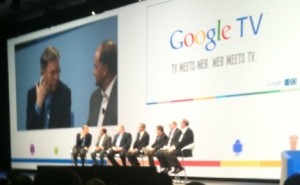While the first day of the Google I/O developer conference concentrated mostly on browser and application technologies, the focus of day 2 was squarely on the operating system: specifically, “Froyo,” the codename for the newly-announced version of the Google Android mobile OS -- and in a total surprise, the Android-based Google TV.
May 21, 2010


google_tv
While the first day of the Google I/O developer conference concentrated mostly on browser and application technologies, the focus of day 2 was squarely on the operating system: specifically, “Froyo,” the codename for the newly-announced version of the Google Android mobile OS — and in a total surprise, the Android-based Google TV. Here are the highlights.First, a tip of the hat: ConnectWise CEO Arnie Bellini sent us the photo above, taken during the Google TV announcement — featuring Google CEO Eric Schmidt and power brokers from Adobe, Intel, Logitec and Sony. Bellini says ConnectWise was one of 80 companies chosen to demo solutions at Google I/O.
Back to the story at hand: With the launch of Froyo, which is the internal name for Android 2.2, Google is adding a lot of functionality to their mobile offerings. The browser now uses V8 for JavaScript, boosting speed by a reported 2 to 3 times, and a new “Just-in-Time” (JIT) compiler boosts application speeds by 2 to 5 times.
Oh, and speaking of the browser, Froyo enables full Adobe Flash support natively — a functionality that’s turning heads after the now-legendary Apple-Adobe war of words. Apple claims that Flash just isn’t stable or efficient enough for modern devices, but Google is now betting big money that Apple is wrong.
But of real value to VARs and ISVs are the expanded API support for enterprise functionality. While Froyo adds Exchange capabilities like account auto-discovery and calendar sync, developers can now leverage device policy management APIs such that applications can control device security features like remote wipe and lockscreen timeout, according to the official Android developers blog.
And while this isn’t necessarily an enterprise feature that VARs can take advantage of, I want to single out the new Android Cloud to Device Messaging API, which enables over-the-air push data sync from desktop to device. In their keynote, Google demonstrated by clicking “Send to Phone” in Google Maps – and the Android phone automatically launched its navigation with the trip that had been preselected. The possibilities are endless.
Going a completely different direction with Android, Google also announced Google TV. It’s exactly the internet-enabling, TV-connecting appliance you think it is. By being the middleman between your existing DVR and television, you can use a Google search bar to find programs to watch and record, making it easier to sift through your hundreds of channels for something decent.
And it’s just as easy to search the web from the same interface while you’re watching TV — which brings us back again to Adobe, since the version of Chrome that Google TV will run also supports it natively. Best of all, to my mind, Google TV can run specially-designed Android apps natively, meaning it’s conceivable that you will soon be able to launch a Twitter client or even a video game from your remote control.
My first instinct was, naturally, to compare it to Apple TV. But while Cupertino’s offering is aimed at streaming video and music from the desktop to the television, Google has its sights set on improving the television experience.
It may well never have an application in the IT channel, but I’m more than interested to see how Google does bringing its open web approach to a technology like television – a technology with a maturation rate that borders on the glacial and an adoption rate that borders on the ubiquitous.
So that’s all the major announcements that Google has for I/O 2010. If you’re an independent Google developer and you announced something at I/O that you think we should know about, feel free to drop me a line at matt [at] ninelivesmediainc.com.
The VAR Guy is going to be following up with updates and perspectives on HTML5, the Chrome Web Store, and Google Android Froyo in the days and weeks to come, so stay tuned.
Sign up for The VAR Guy’s Newsletter; Webcasts and Resource Center; and via RSS; Facebook; Identi.ca; Twitter and VARtweet.
About the Author(s)
You May Also Like


